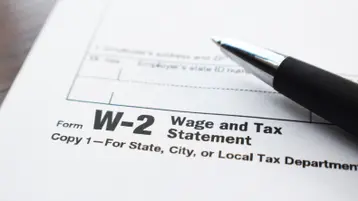
Your Form W-2 impacts your federal and state tax filings. It’s therefore imperative that you get your W-2 on time. But what is a W-2? When should you receive it? How do you read a W-2? And what should you do if you find an error on your W-2? Read on for answers.
What is a W2?
IRS Form W-2, Wage and Tax Statement, is used by employers to report employees’ annual wages and salaries, taxes withheld, and other compensation. Your employer must give you:
- Your Form W-2 if they paid you at least $600 for the year
- Copy B to file with your federal income tax return
- Copy 2 to file with your state or local tax return, if applicable
- Copy C to retain for your records
Only employees receive form W-2.
When does a W2 come out?
Your employer has until January 31 to furnish Forms W-2 to employees. If the deadline falls on a Saturday, Sunday, or legal holiday, your employer must furnish Forms W-2 by the following business day. Employers that provide online access to Forms W-2 must do so by January 31. Those that don’t supply online access must mail or hand-deliver Forms W-2 no later than January 31. If don’t receive your Form W-2 by the deadline, let your employer know so they can resolve the issue.
How to read a W-2 form?
Though your Form W-2 is essentially about how much money you earned and the amount of taxes you paid, it’s also a detailed document. It shows, for instance, your retirement plan contributions, the amount your employer paid for your health insurance, and nontaxable income you received from your employer.
Here’s a breakdown of relevant W-2 boxes:
- Box 1:
- Total wages — including salaries, tips, and other compensation — subject to federal income tax. Box 1 does not show pre-tax deductions or nontaxable wages.
- Box 2:
- Federal income tax withheld from your wages.
- Box 3:
- Wages subject to Social Security tax. This amount should not exceed the annual Social Security wage limit.
- Box 4:
- Social Security tax withheld from your wages.
- Box 5:
- Wages subject to Medicare tax. No annual wage limit applies to Medicare tax.
- Box 6:
- Medicare tax withheld from your wages. This includes regular Medicare tax, and if applicable, the additional Medicare tax of 0.9% for high-income earners.
- Box 7:
Tips you reported (to your employer) that were subject to Social Security tax. This amount is also reflected in Box 1 wages.
- Box 8:
- Tips your employer allocated to you. This amount is not shown in Box 1 wages.
- Box 10:
- Dependent care benefits you received from your employer. If you contributed more than the annual pre-tax limit, the excess amount is taxable and includable in Box 1 wages.
- Box 11:
- Taxable amounts distributed to you from your employer’s non-qualified deferred compensation plan.
- Box 12:
- Used to deliver information about various types of compensation and benefits, such as taxable group-term life insurance, elective deferrals to a 401(k) plan, Roth 401(k) contributions, adoption benefits, nontaxable sick pay, and cost of employer-sponsored health coverage. Refer to the IRS guidelines on values for this field.
- Box 13:
- Your employer must check whichever applies:
- You’re a statutory employee
- You contributed to your employer’s retirement plan
- You received third-party sick pay
- Box 14:
- Other information your employer wants you to know, such as state disability insurance tax withheld, union dues, tuition assistance payments, health insurance premiums deducted, and uniform payments.
- Box 16:
- Wages subject to state income tax.
- Box 17:
- State income tax withheld from your wages.
- Box 18:
- Wages subject to local taxes, such as city or county taxes.
- Box 19:
- Local taxes withheld from your wages.
What if there’s an error on my W2 form?
If you see a mistake on your W-2 — such as incorrect name, incorrect Social Security Number, incorrect wages, or incorrect taxes withheld — let your employer know as soon as possible. Depending on the error, your employer may need to give you a corrected W-2 via Form W-2c, which you can then use to amend your tax returns if necessary. Having trouble getting your employer to correct your W-2?
This communication is for informational purposes only; it is not legal, tax or accounting advice; and is not an offer to sell, buy or procure insurance.
This post may contain hyperlinks to websites operated by parties other than TriNet. Such hyperlinks are provided for reference only. TriNet does not control such web sites and is not responsible for their content. Inclusion of such hyperlinks on TriNet.com does not necessarily imply any endorsement of the material on such websites or association with their operators.






